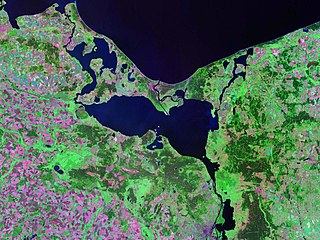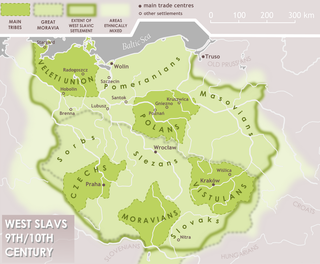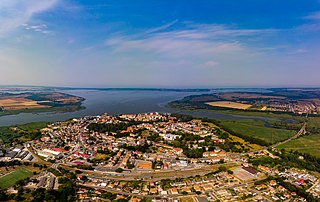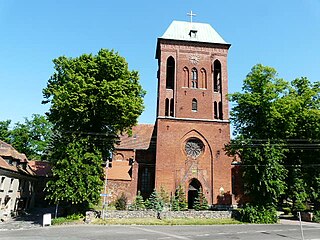Niedamir (Latin: Nedamirus) was a 12th-century merchant and magnate, from the tribe of Wolinians, who lived in the settlement of Wolin. He was described by Catholic monk Ebo, in his writings about the life of missionary Otto of Bamberg. [1] [2] [3]
Niedamir (Latin: Nedamirus) was a 12th-century merchant and magnate, from the tribe of Wolinians, who lived in the settlement of Wolin. He was described by Catholic monk Ebo, in his writings about the life of missionary Otto of Bamberg. [1] [2] [3]
Niedamir was mentioned by Catholic monk Ebo, in his writings about the life of missionary Otto of Bamberg. According to him, Niedamir was a wealthy merchant, from the tribe of Wolinians, who lived in the settlement of Wolin. He possessed considerable property and was highly respected among his tribe. In his youth, he lived at the Saxonian court, where he was baptized, and after returning to his homeland, he secretly continued to practice Christianity. [1] [2] He had donated three ships from his merchant feet to the Christian missionary Otto of Bamberg when he arrived in Wolin, for him to use them in his travel to Szczecin. [3] [2]
In 2007, in the town of Kamień Pomorski, Poland, launched a project to build replicas of historical ships, used during the High Middle Ages, in the Szczecin Lagoon. It was titled Klucz Niedamir (translation from Polish: Niedamir Key), in his honor. One of the ships build during the project, was also named Niedamir. [4]

Mieszko I was Duke of Poland from 960 until his death in 992 and the founder of the first unified Polish state, the Civitas Schinesghe. A member of the Piast dynasty, he was the first Christian ruler of Poland and continued the policies of both his father Siemomysł and grandfather Lestek, who initiated a process of unification among the Polish tribes and the creation of statehood.

Pomerania is a historical region on the southern shore of the Baltic Sea in Central Europe, split between Poland and Germany. The central and eastern part belongs to the West Pomeranian, Pomeranian and Kuyavian-Pomeranian voivodeships of Poland, while the western part belongs to the German states of Mecklenburg-Western Pomerania and Brandenburg.

Wolin is a Polish island in the Baltic Sea, just off the Polish coast. Administratively, the island belongs to the West Pomeranian Voivodeship. Wolin is separated from the island of Usedom (Uznam) by the Strait of Świna, and from mainland Pomerania by the Strait of Dziwna. The island has an area of 265 km2 (102 sq mi) and its highest point is Mount Grzywacz at 116 m above sea level. The number of inhabitants is 30,000. Eastern suburbs of the city of Świnoujście extend to the Wolin island, while the towns of Międzyzdroje and Wolin lie further east.

Otto of Bamberg was a German missionary and papal legate who converted much of medieval Pomerania to Christianity. He was the bishop of Bamberg from 1102 until his death. He was canonized in 1189.

Świnoujście is a city in Western Pomerania and seaport on the Baltic Sea and Szczecin Lagoon, located in the extreme north-west of Poland. Situated mainly on the islands of Usedom and Wolin, it also occupies smaller islands. The largest is Karsibór island, once part of Usedom, now separated by the Piast Canal dug in the late 19th century to facilitate ship access to Szczecin.

Białogard is a historic town in Middle Pomerania, northwestern Poland, with 23,614 inhabitants as of December 2021. The capital of Białogard County in the West Pomeranian Voivodeship. It is the most important railroad junction of Middle Pomerania, which links Kołobrzeg with Piła and Gdańsk with Stargard.

The Pomeranians, first mentioned as such in the 10th century, were a West Slavic tribe, which from the 5th to the 6th centuries had settled at the shore of the Baltic Sea between the mouths of the Oder and Vistula Rivers. They spoke the Pomeranian language that belonged to the Lechitic languages, a branch of the West Slavic language family.

Triglav was the chief god of the Pomeranian and probably some of the Polabian Slavs, worshipped in Szczecin, Wolin and probably Brenna. His cult is attested in several biographies of the bishop St. Otto of Bamberg in the years immediately preceding his suppression of it in 1127.

The history of Pomerania starts shortly before 1000 AD, with ongoing conquests by newly arrived Polan rulers. Before that, the area was recorded nearly 2000 years ago as Germania, and in modern times Pomerania has been split between Germany and Poland. Its name comes from the Old Polish po more, which means "(land) at the sea".

Kamień Pomorski is a spa town in the West Pomeranian Voivodeship of north-western Poland, on the Baltic coast. It is the seat of an urban-rural gmina in Kamień County which lies approximately 63 km to the north of the regional capital Szczecin. It is the second seat of the Archdiocese of Szczecin-Kamień and the deanery of Kamień.

Wolin is a town in northwestern Poland, situated on the southern tip of the Wolin island off the Baltic coast of the historic region of Western Pomerania. The island lies at the edge of the strait of Dziwna in Kamień County, West Pomeranian Voivodeship.

Wartislaw I was the first historical ruler of the Duchy of Pomerania and the founder of the Griffin Dynasty.

The Bishopric of Cammin was both a former Roman Catholic diocese in the Duchy of Pomerania from 1140 to 1544, and a secular territory of the Holy Roman Empire (Prince-Bishopric) in the Kołobrzeg area from 1248 to 1650.
Adalbert of Pomerania was the first bishop of the 12th century Pomeranian bishopric, with its see in Wolin. He was a monk of the Michaelsberg Abbey, Bamberg and former chaplain to Bolesław III Wrymouth of Poland, whence he knew the Pomeranian language of the temporarily Polish-subjugated West Slavic population, whereas the Joms Vikings and other Germanic inhabitants of the Pomeranian coast understood his old German language.

Pomerania during the High Middle Ages covers the history of Pomerania in the 12th and 13th centuries.
Medieval Pomerania was converted from Slavic paganism to Christianity by Otto of Bamberg in 1124 and 1128, and in 1168 by Absalon.

Historical Western Pomerania, also called Cispomerania,Fore Pomerania, Front Pomerania or Hither Pomerania, is the western extremity of the historic region of Pomerania forming the southern coast of the Baltic Sea, located mostly in north-eastern Germany, with a small portion in north-western Poland.

Yarovit, Iarovit is a Polabian god of war, worshipped in Vologošč (Circipanians) and Hobolin. Sources give only a brief description of his cult, his main temple was located in Vologošč, where there was a golden shield belonging to Yarovit. By one Christian monk he was identified with the Roman Mars.

Polish–Veletian War was a military conflict fought between 963 and 967, by the Duchy of Poland led by Mieszko I, with later aid of the Duchy of Bohemia against the Confederacy of the Veleti led by Wichmann the Younger, with later aid of Wolinians. The war consisted of 3 Veletian campaigns against Poland, the first two of which were won by Veleti, and the last one by Poland, ending the war and establishing Polish hegemony in the Farther Pomerania.

The Battle between Mieszko I and Wichmann was the decisive last battle of Polish–Veletian War, fought on 21 or 22 September 967, between Duchy of Poland led by Mieszko I, with aid of the Duchy of Bohemia against the Confederacy of the Veleti led by Wichmann the Younger, with aid of Wolinians. The exact location of the battle remains unknown, though, some historians assume that it happened near Santok. The battle had ended with decisive Polish victory, leading to the end of the war. Veleti and Wolinians had received devastatingly heavy casualties, while the self-proclaimed leader of the army, Wichmann the Younger had died shortly after battle.